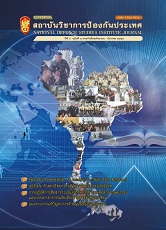ASEAN กับ สถาปัตยกรรมด้านความมั่นคงของภูมิภาค
Main Article Content
Abstract
เอเชียตะวันออกเฉียงใต้ในศตวรรษที่ ๒๑ มีบทบาทมากขึ้น เกิดการเปลี่ยนผ่านของอำนาจ (Transition of power) ซึ่งเป็นระบบโลกที่สหรัฐฯ เป็นศูนย์กลาง (US. Centric World Order) เป็นระบบที่เปลี่ยนผ่านไปสู่ระบบใหม่ สำหรับสถาปัตยกรรมด้านความมั่นคง หมายถึง การจัดรูปแบบความสัมพันธ์ หรือ ระเบียบโลก (World Order) หรือระเบียบในภูมิภาค โดยสถาปัตยกรรมความมั่นคงยังหมายถึงโครงสร้างความร่วมมือทางด้านความมั่นคง (Regional Cooperation Structure) หรือ โครงสร้างความสัมพันธ์ทางด้านความมั่นคงระหว่างประเทศต่างๆ ในภูมิภาค ซึ่งประกอบด้วย ๑) ความเข้าใจร่วมกัน (Common Understanding ๒) มีกฎกติการ่วมกัน (Common Norms) และ ๓) มีความคาดหวังร่วมกัน (Common Expectation) ทั้งหมดรวมเป็นโครงสร้างความสัมพันธ์ทางด้านความมั่นคง เพื่อเป้าหมายในการสร้างเสถียรภาพในภูมิภาค (Regional Stability)
ปัจจุบันสถาปัตยกรรมความมั่นคงในเอเชียตะวันออกเฉียงใต้ มี ๒ วง ได้แก่ ๑) ระบบที่สหรัฐฯ เป็นศูนย์กลาง US. Centric Security Architecture (Hub and Spoke) ลักษณะเด่นคือเป็นระบบที่มีประสิทธิภาพสูง เนื่องจากเป็นข้อตกลงที่เป็นลายลักษณ์อักษร มีความร่วมมือที่ชัดเจน ๒) ระบบสถาปัตยกรรมความมั่นคงที่มีอาเซียนเป็นศูนย์กลาง (ASEAN Centrality Security Cooperation Structure) มีข้อดี คือ ความเท่าเทียมกัน และการแลกเปลี่ยน สำหรับข้อด้อย คือ ความเป็น
พหุภาคี (Multilateral) ทำให้การได้รับฉันทามติจะกระทำได้ยาก ส่งผลให้ประสิทธิภาพในการบริหารความขัดแย้งลดลง สำหรับแนวโน้มสถาปัตยกรรมความมั่นคงในภูมิภาคในอนาคต อาจเกิดได้ ๓ อุบัติการณ์ ๑) Co-Existence US. Centric Security Structure คือ โครงสร้างทางด้านความมั่นคงร่วมกันระหว่างอาเซียนและสหรัฐฯ ที่เรียกว่า “Hub and spoke” โดยมีอาเซียน สหรัฐฯ และจีนรวมอยู่ด้วย ๒) Co-Existence But Not Work Together คือ การมีบทบาทสัมพันธ์แต่ไม่ทำงานร่วมกัน นั่นคือ การที่สหรัฐฯ มีบทบาท และให้การสนับสนุนฟิลิปปินส์และเวียดนาม ส่วนอาเซียนไม่มีบทบาท อำนาจ หรือ เอกภาพในการแก้ปัญหา และ ๓) แบบทวิภาคี (Bilateral) คือ อาเซียนไม่สามารถดำเนินการได้ต้องเกิด New security structure ที่มีจีนเป็นศูนย์กลาง แต่ต้องใช้ความยึดหยุ่นแบบ ๓ เส้า ระหว่าง สหรัฐฯ – จีน – อาเซียน เกิดเป็น New security architecture
ASEAN, in the 2st Century, has ever increasingly more important roles in the World. There has been shifted from the old World of US centric into the new system of World order. By definition, security architecture generally means forms or sets of relationship between countries within the region, including, the cooperation structure among them. These may include the followings; 1) Common Understanding 2) Common Norms 3) Common Expectation. These are components of regional security relationship or structure for stability of the region itself.
Currently, security architecture within ASEAN has two main characteristics, which are 1) The U.S. Centric Security Architecture (Hub and Spoke), which is considered to be most effective since it is based on written agreements and pre-defined cooperation, 2) ASEAN Centrality Security Cooperation, which has many desirable characteristics such as equality, faire exchanges, but the down sides is its multilateralism in nature which consensus is difficult, therefore lessening its effectiveness in resolving disputes. For future security architecture, there may be three types of outcomes. They are 1) Co-Existence Security Structure in which is also called Hub and Spoke with ASEAN, U.S., and China take part in the scheme, 2) Co-Existence but Not Work Together in which the U.S. has important roles in supporting the Philippines and Vietnam, but, ASEAN has less significant roles to contribute due to its lacking of consensus on the issue, 3) Bilateral in which ASEAN is not effective, therefore, there rises new security architecture with China as the center, but, with loosen cooperation between the U.S. – China – ASEAN.
Article Details
The articles, images, tables, graphs, written content, and opinions published in this journal are solely those of the authors and do not necessarily reflect the views or positions of the National Defence Studies Institute or its academic affiliates.


